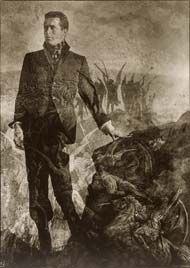
 |
 |
Kenneth Anger, Topanga Canyon, California, Composite with Gustave Doré Engraving, 1960s
© Edmund Teske Archives/Laurence Bump and Nils Vidstrand, 2001
|
 |
 |
|
|
 |
Teske's inventive narrative style is manifest in this study of the filmmaker Kenneth Anger. Teske created this picture by combining an image of the dashingly attired Anger posing atop a bluff in Topanga Canyon with an engraving by artist Gustave Doré illustrating a scene from Milton's Paradise Lost. Anger's face registers an expression of deliberation mixed with arrogance, while the chorus of rebel angels behind him seems to celebrate his creative powers and commanding physical presence.
|
 |
 |
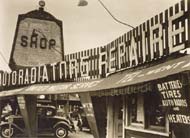
 |
 |
Chicago, 1940
© Edmund Teske Archives/Laurence Bump and Nils Vidstrand, 2001
|
 |
Teske began his photographic work as a youth in Chicago, where he immersed himself in the artistic community and enjoyed music and acting. He explored Chicago with his camera, photographing street scenes, industrial and commercial buildings, storefronts, workers, children, and any subject that seemed essential to his definition of the city.
Teske delighted in the eccentric architecture and signage of small, independently-owned businesses. The competing visual rhythms of this type-laden automotive repair shop clearly caught his eye. Teske depicted the letters in the same tone as the sky, creating an ambiguous relationship between them, an effect particular to the abstract qualities of photography.
|
 |

 |
 |
Richard Soakup, Chicago, 1940
© Edmund Teske Archives/Laurence Bump and Nils Vidstrand, 2001
|
 |
 |
|
|
 |
Teske took this photograph of his lover Richard Soakup shortly after returning to Chicago from New York where he worked as an assistant to documentary photographer Berenice Abbott. Here Teske merges a common theme of documentary photography—people at work—with his personal interest in photographing the male figure. Soakup emerges from the very dark background, with light focused on his tousled hair and bare chest. Although Soakup is engaged in labor usually associated with men, the intimate image has a soft, almost feminine, quality to it.
|
 |
 |
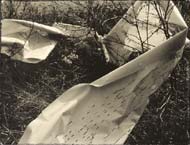
 |
 |
Chicago, 1938–1940
© Edmund Teske Archives/Laurence Bump and Nils Vidstrand, 2001
|
 |
 |
|
Teske's early photographs in Chicago include studies revealing the end product of consumer culture. In the industrial wasteland around Chicago's steel mills, dumps, and shanties, he found unexpected but richly rewarding subjects. In these images, abandoned household objects disintegrate into the vegetation that grows up around them.
Teske felt that photographing such objects could elevate them and reveal their larger significance, explaining: "Their emotional value is physical—being strong in structure and movement—and sensuous in textural rendition. They are experienced rather than recognized." Frozen by photography in the process of losing their materiality, these objects echo in microcosm the city's relationship to nature.
|
 |
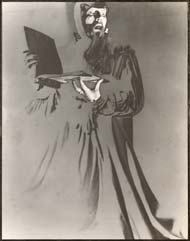
 |
 |
Robert Schrewsbury as Mephisto in Faust, Chicago, March 1936
© Edmund Teske Archives/Laurence Bump and Nils Vidstrand, 2001
|
 |
 |
|
|
 |
Solarization, the process by which some of the tones in a photograph are reversed, often yields unpredictable results. Teske fearlessly experimented with darkroom technique, relishing the one-of-a-kind images he produced with alternative darkroom procedures. Years after his accidental discovery of solarization while developing this negative, Teske recalled: "The gods received me into the secret chambers of an exquisite photographic happening, which for me is the high point of purity."
|
 |
 |
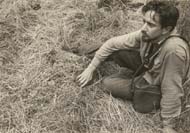
 |
 |
Self-Portrait, Olive Hill, Hollywood, 1945
© Edmund Teske Archives/Laurence Bump and Nils Vidstrand, 2001
|
 |
In 1943 Teske moved from Chicago to Los Angeles, compelled by romantic notions of sunshine, the silver screen, and the possibility of a new way of life. He soon began to mix freely with its small but tight-knit community of artists, including Man Ray, writer Anaïs Nin, film directors Lewis Milestone and George Cukor, and architect John Lautner.
Aline Barnsdall, a wealthy oil heiress and client of Frank Lloyd Wright, invited Teske to Olive Hill, a 36-acre site in Hollywood where she wished to establish a center for the arts. When Teske first visited Olive Hill, the property was largely abandoned. Barnsdall later invited him to occupy Studio Residence B, a vacant structure on the site, adjacent to Wright's Hollyhock House (see image below).
|
 |
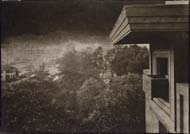
 |
 |
North Wing of Studio Residence B, Hollyhock House, Hollywood, negative 1944–49
© Edmund Teske Archives/Laurence Bump and Nils Vidstrand, 2001
|
 |
 |
During the four years Teske lived at Studio Residence B, his work flourished and the studio became a magnet for the city's artists' community.
In this print of the site, the question of how this building supports itself is left to the imagination. The dramatic perspective accentuates the weighty, angular presence of Frank Lloyd Wright's architecture. The building dwarfs the surrounding groves of olive and eucalyptus trees and looms over the hustle and bustle of Hollywood Boulevard with its trolley cars and traffic. The skillful solarization in the middle of the composition enhances the supernatural aura of Wright's architecture.
|
 |






